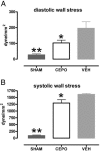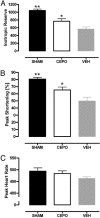A nonerythropoietic derivative of erythropoietin protects the myocardium from ischemia-reperfusion injury
- PMID: 15671158
- PMCID: PMC548534
- DOI: 10.1073/pnas.0409329102
A nonerythropoietic derivative of erythropoietin protects the myocardium from ischemia-reperfusion injury
Abstract
The cytokine erythropoietin (EPO) protects the heart from ischemic injury, in part by preventing apoptosis. However, EPO administration can also raise the hemoglobin concentration, which, by increasing oxygen delivery, confounds assignment of cause and effect. The availability of EPO analogs that do not bind to the dimeric EPO receptor and lack erythropoietic activity, e.g., carbamylated EPO (CEPO), provides an opportunity to determine whether EPO possesses direct cardioprotective activity. In vivo, cardiomyocyte loss after experimental myocardial infarction (MI) of rats (40 min of occlusion with reperfusion) was reduced from approximately 57% in MI-control to approximately 45% in animals that were administered CEPO daily for 1 week (50 microg/kg of body weight s.c.) with the first dose administered intravenously 5 min before reperfusion. CEPO did not increase the hematocrit, yet it prevented increases in left ventricular (LV) end-diastolic pressure, reduced LV wall stress in systole and diastole, and improved LV response to dobutamine infusion compared with vehicle-treated animals. In agreement with the cardioprotective effect observed in vivo, staurosporine-induced apoptosis of adult rat or mouse cardiomyocytes in vitro was also significantly attenuated ( approximately 35%) by CEPO, which is comparable with the effect of EPO. These data indicate that prevention of cardiomyocyte apoptosis, in the absence of an increase in hemoglobin concentration, explains EPO's cardioprotection. Nonerythropoietic derivatives such as CEPO, devoid of the undesirable effects of EPO, e.g., thrombogenesis, could represent safer and more effective alternatives for treatment of cardiovascular diseases, such as MI and heart failure. Furthermore, these findings expand the activity spectrum of CEPO to tissues outside the nervous system.
Figures




Similar articles
-
Carbamylated erythropoietin protects the myocardium from acute ischemia/reperfusion injury through a PI3K/Akt-dependent mechanism.Surgery. 2009 Sep;146(3):506-14. doi: 10.1016/j.surg.2009.03.022. Epub 2009 Jun 9. Surgery. 2009. PMID: 19715808
-
Erythropoietin (EPO) affords more potent cardioprotection by activation of distinct signaling to mitochondrial kinases compared with carbamylated EPO.Cardiovasc Drugs Ther. 2010 Dec;24(5-6):401-8. doi: 10.1007/s10557-010-6265-5. Cardiovasc Drugs Ther. 2010. PMID: 20953685
-
Erythropoietin, modified to not stimulate red blood cell production, retains its cardioprotective properties.J Pharmacol Exp Ther. 2006 Mar;316(3):999-1005. doi: 10.1124/jpet.105.094854. Epub 2005 Nov 23. J Pharmacol Exp Ther. 2006. PMID: 16306273
-
An update on the cardiac effects of erythropoietin cardioprotection by erythropoietin and the lessons learnt from studies in neuroprotection.Cardiovasc Res. 2004 Aug 1;63(2):208-16. doi: 10.1016/j.cardiores.2004.03.017. Cardiovasc Res. 2004. PMID: 15249178 Review.
-
Molecular basis of cardioprotection by erythropoietin.Curr Mol Pharmacol. 2009 Jan;2(1):56-69. doi: 10.2174/1874467210902010056. Curr Mol Pharmacol. 2009. PMID: 20021446 Review.
Cited by
-
Erythropoietin for the Treatment of Subarachnoid Hemorrhage: A Feasible Ingredient for a Successful Medical Recipe.Mol Med. 2016 Mar;21(1):979-987. doi: 10.2119/molmed.2015.00177. Epub 2015 Nov 16. Mol Med. 2016. PMID: 26581085 Free PMC article.
-
Erythropoietin and a nonerythropoietic peptide analog promote aortic endothelial cell repair under hypoxic conditions: role of nitric oxide.Hypoxia (Auckl). 2016 Aug 16;4:121-133. doi: 10.2147/HP.S104377. eCollection 2016. Hypoxia (Auckl). 2016. PMID: 27800514 Free PMC article.
-
Promises and pitfalls in erythopoietin-mediated tissue protection: are nonerythropoietic derivatives a way forward?J Investig Med. 2011 Oct;59(7):1073-82. doi: 10.2310/JIM.0b013e3181ed30bf. J Investig Med. 2011. PMID: 20683348 Free PMC article. Review.
-
Potential of Novel EPO Derivatives in Limb Ischemia.Cardiol Res Pract. 2012;2012:213785. doi: 10.1155/2012/213785. Epub 2012 Feb 22. Cardiol Res Pract. 2012. PMID: 22462027 Free PMC article.
-
Cardioprotection by a nonerythropoietic, tissue-protective peptide mimicking the 3D structure of erythropoietin.Proc Natl Acad Sci U S A. 2010 Aug 10;107(32):14357-62. doi: 10.1073/pnas.1003019107. Epub 2010 Jul 26. Proc Natl Acad Sci U S A. 2010. PMID: 20660739 Free PMC article.
References
-
- Gong, H., Wang, W., Kwon, T. H., Jonassen, T., Li, C., Ring, T., Froki, A. J. & Nielsen, S. (2004) Kidney Int. 66, 683–695. - PubMed
-
- Yang, C. W., Li, C., Jung, J. Y., Shin, S. J., Choi, B. S., Lim, S. W., Sun, B. K., Kim, Y. S., Kim, J., Chang, Y. S. & Bang, B. K. (2003) FASEB J. 17, 1754–1755. - PubMed
Publication types
MeSH terms
Substances
LinkOut - more resources
Full Text Sources
Other Literature Sources
Research Materials

